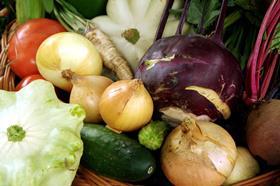
With the exception of vegetables du jour kale and cauliflower, the main veg lines are either flat or in value decline.
Staples such as carrots (-4.2 per cent), onions (-3 per cent), courgette (-4.9 per cent), broccoli (+0.4 per cent) and cabbage (+0.9 per cent) continue to see price deflation as retailers attempt to drive volume into the category, with varying degrees of success.
In carrots and parsnips, particularly deep promotions during the last year peaked around Christmas but have not helped bring new consumers into the category, according to category manager at Produce World, Mark Cheadle, who says primary usage of root veg remains locked to key eating occasions such as the Sunday roast. On the other hand, deflation in onions has helped the category piggyback onto trends such as emerging cuisines, with consumers choosing the cooking staple for Indian and other Asian recipes. “What we’re seeing is retailers have pushed the relevance of onions with new usage occasions and so the value decline hasn’t been as severe,” he says.
The umbrella trend behind this category-wide deflation could be an adoption of the European EDLP model by UK retailers, says Cheadle. “Europe has always been an EDLP price model, whereas Britain has traditionally relied on deals and promotions. Aldi and Lidl have brought that EDLP model over here and now that’s becoming the norm,” he says.
Challenging exchange rates are another key driver of onion price deflation, says managing director of the Allium Alliance, Malcolm Gray, affecting southern hemisphere imports that are traded in dollars. “Only two things can happen – exporters will have accept less or consumers will have to pay more,” he explains. In Ireland, Brexit-related pressure on the euro-sterling exchange rate is creating similar headaches for mushroom exporters. Category trends vary but one thing is clear: if retail deflation continues, the veg supply base has an extremely challenging period ahead.
On the markets, traders have their hands full with peak English vegetable season, with good prices reported for broad beans, bunched carrots, beets, cauliflower, and new crop root veg. “For peas and runner beans, the price has fallen a bit; the warm weather and rain has given the skin finish a slight white colour and the purple sprouting have some yellow making them harder to sell,” says Mark Gregory, salesman at New Covent Garden Market firm P&I Fruits. “Runner beans are £6-7 a box (5kg) and peas are currently £7.50 for 4kg,” he adds.
Bean grower Andrew Green reported an “exceptional crop” at the start of his Herefordshire season, but warned the summer could turn out to be a bumpy ride. “This season will be more fluctuating, we have had a rollercoaster of weather conditions, which usually leads to a rollercoaster of supply,” he says. “The bean season will run until 20 October, although we did start a couple of days early. The most critical factor facing our industry is labour; we urgently need another SAWS scheme. We were okay this year, but it’s getting harder.”
One trend that appears to be benefiting a variety of veg lines is the growing popularity of stir fries, with increasing amounts of retail shelf space given over to ingredients for this convenient dish. Elsewhere, shredding and spiralising continue to give life to NPD in squash and courgettes, as well as swede, although managing director of MH Poskitt, Guy Poskitt, warns that processing is labour-intensive and products look expensive compared to wholehead formats.



